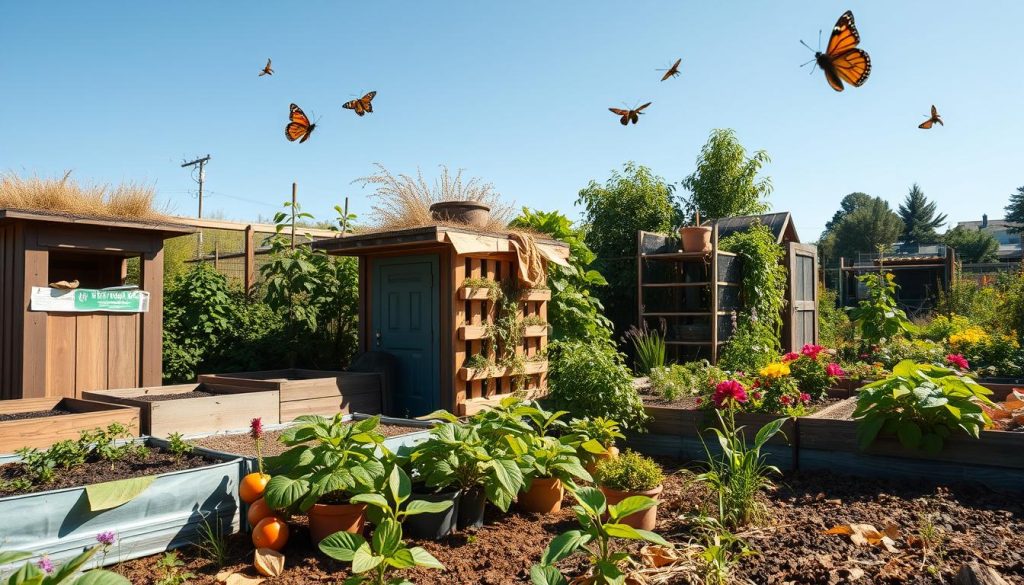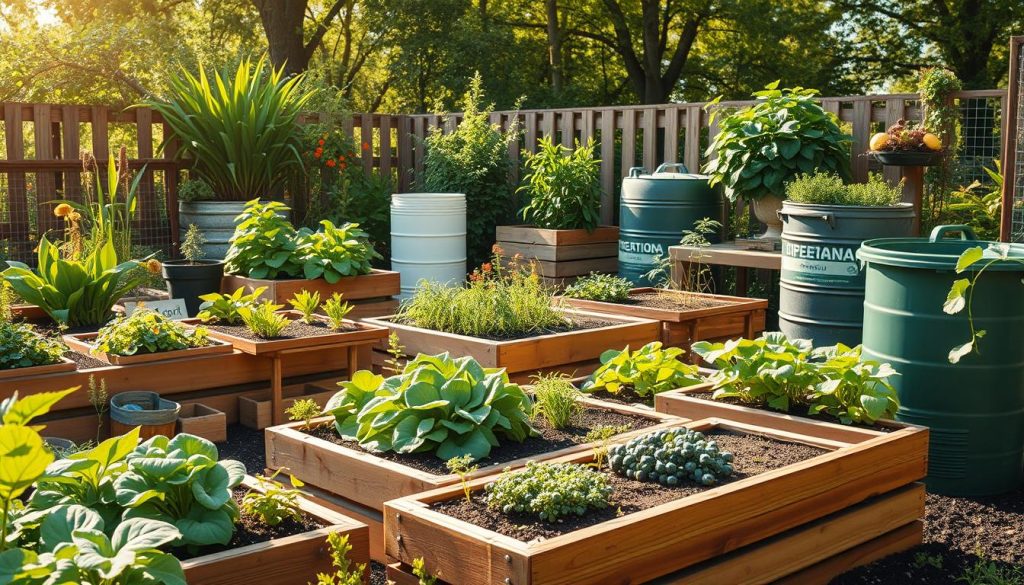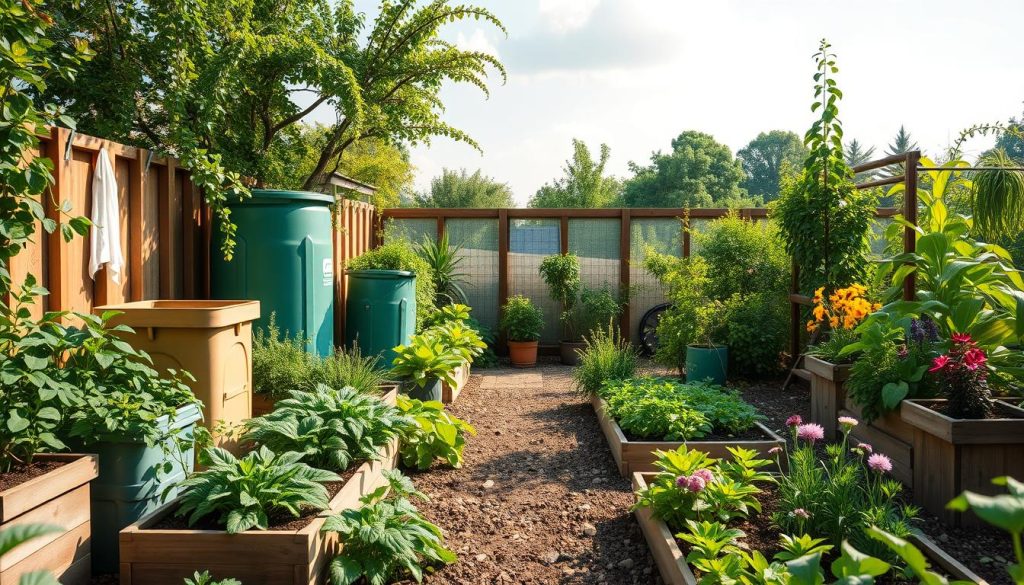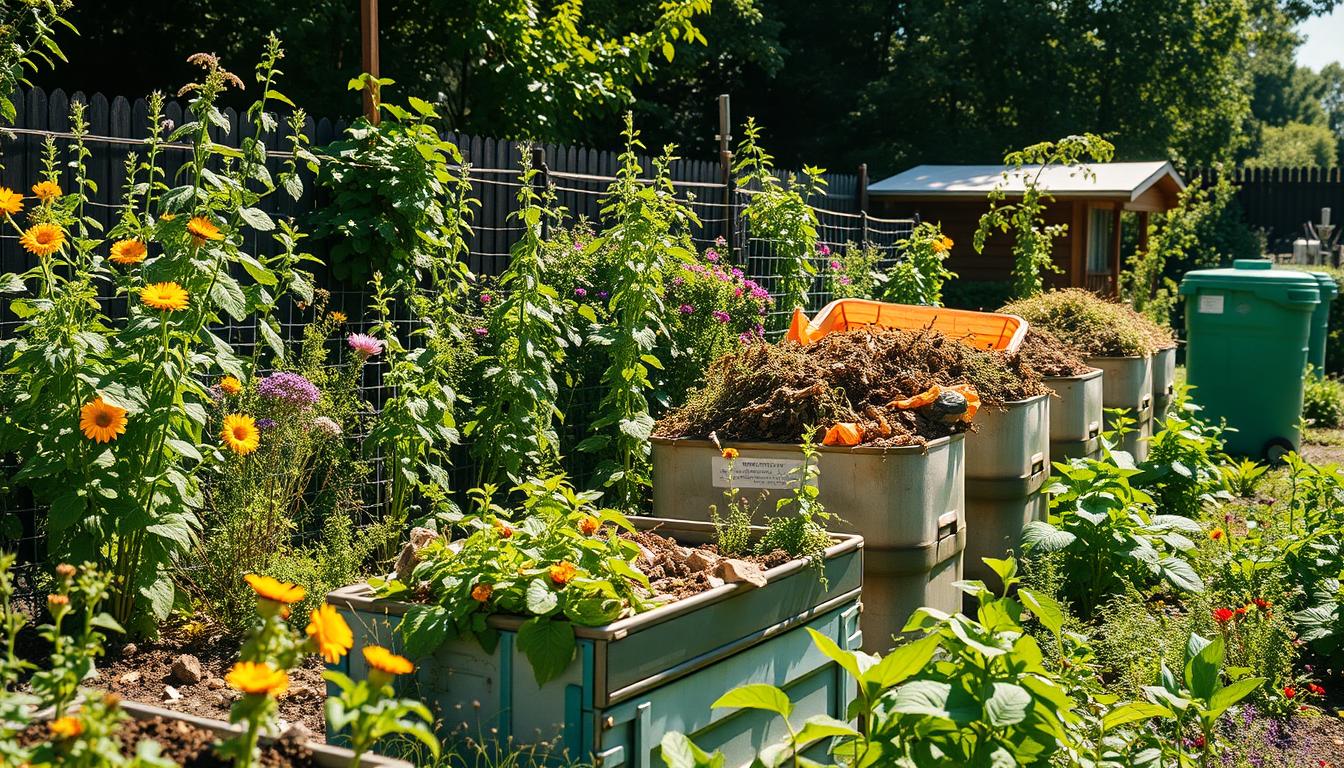Starting a zero-waste garden was a big step for me. I learned a lot about sustainable gardening and eco-friendly tips. It helped me cut down on waste and make my garden better for my family and the planet.
My journey showed me that making a zero-waste garden is easy and fulfilling. I want to share what I learned with you. Together, we can make our gardens greener and healthier for everyone.
Why I Decided to Create a Zero-Waste Garden
Learning about gardening’s environmental impact made me want to reduce waste in my garden. I started using minimal waste gardening practices. This not only cut down on waste but also made my garden healthier. By using zero-waste techniques, I saved resources and supported sustainability.
I wanted to lessen my environmental impact by starting a zero-waste garden. I looked at my gardening habits and found ways to improve. I aimed to reduce waste, like food scraps and yard trimmings, and find new uses for them.
My Journey to Sustainability
My path to sustainability started with small steps. I began composting kitchen scraps and using rainwater for my plants. As I learned more, I added more zero-waste methods to my garden. This included natural pest control and fewer chemical fertilizers, making my garden diverse and healthy.
Understanding the Benefits of Zero-Waste Gardening
Zero-waste gardening has many advantages. It reduces waste, saves resources, and makes the environment healthier. By adopting these practices, gardeners can lessen their environmental impact and support sustainability. Key benefits include:
- Reduced waste: Composting and reusing materials greatly cuts down garden waste.
- Conserved resources: Techniques like rainwater harvesting and composting save water and reduce waste management needs.
- Healthier environment: Using fewer chemicals makes the garden safer for people and wildlife.

Getting Started with Zero-Waste Principles
To start your organic gardening journey, understanding zero-waste gardening is key. This method aims to cut down on waste and lessen harm to the environment. Beginners can begin with simple projects like composting and using old items in new ways.
Many think organic gardening is hard and needs lots of resources. But, with the right approach, you can have a green and productive garden. Here are some important tips:
- Start small and grow your garden gradually to avoid feeling overwhelmed
- Pick plants that fit your local climate and soil
- Use natural and organic ways to fight pests and feed your plants
By following these tips and adopting waste-free gardening, you can make a stunning and eco-friendly garden. This garden will not only help the environment but also give you fresh, healthy food.
Defining Zero-Waste in Gardening
Zero-waste gardening means cutting down on waste and reducing harm to the environment. You can do this by using recycled stuff, composting, and avoiding chemicals. As you start your organic gardening, remember every small action helps. These choices can greatly benefit your garden and the planet.
Common Misconceptions About Zero-Waste
Many think zero-waste gardening is too much work and expensive. But, with a bit of creativity and planning, you can have a beautiful, eco-friendly garden. By using beginner-friendly organic gardening methods and waste-free projects, you can enjoy gardening while helping the environment.
Choosing the Right Location for My Garden
Creating a zero-waste garden starts with the right location. I looked at sunlight, space, and soil quality. This ensured my garden would grow well using green gardening tips.
By picking a spot with the right sunlight and enough room, I could use smart gardening tricks. These include planting plants together and changing where they grow.
Assessing Sunlight and Space
I checked how much sunlight the spot got and how big it was. Most plants need full sun to partial shade. I also thought about how big each plant would get.
I planned the garden’s layout to make sure plants had enough room. This lets air move around and helps plants grow better.
The Importance of Soil Quality
Soil quality is key for a healthy garden. I tested my soil to see its pH level and nutrients. Then, I made it better using natural methods.
By focusing on soil and using green gardening, I cut down on waste. My garden now grows well with little help from outside.

By carefully choosing and planning, I made a zero-waste garden. It not only cuts down on waste but also gives me fresh food.
Planning My Garden Layout
When I started planning my zero-waste garden, I knew it was key to use space wisely. I thought about where each plant should go, based on how they grow and what they need. This way, I aimed to make a garden that’s both sustainable and full of life.
I looked for ideas on sustainable landscaping to guide me. I found out about companion planting, which pairs plants for mutual benefit. This method not only makes the garden more sustainable but also helps plants grow well together.
Companion Planting for Sustainability
Companion planting is a smart way to balance the garden’s ecosystem. It lets me avoid using harmful pesticides by pairing plants that repel pests or attract good bugs. For instance, marigolds can keep nematodes away from tomatoes, while basil and mint can make nearby plants taste and smell better.
Utilizing Vertical Gardening Techniques
Vertical gardening is another big part of my garden plan. Using walls and trellises, I make the most of my space and create a lush garden. This method also cuts down on waste by needing less land and resources. Popular vertical gardening styles include living walls, green roofs, and container gardens.

By using these sustainable ideas, I’m building a garden that’s not only beautiful but also good for the planet. It’s a place where I can relax and enjoy nature’s beauty.
Sourcing Materials for My Zero-Waste Garden
To make a zero-waste garden, finding the right materials is key. I look for ways to reduce waste and garden with less. Repurposing items from home is a great start. Old containers, cardboard tubes, and plastic bottles can become planters and tools.
Repurposing Household Items
Here are some creative ways to reuse household items:
- Old mason jars can be mini greenhouses for seedlings.
- Plastic bottles can turn into self-watering planters.
- An old wooden pallet can become a compost bin.
Local Resources for Gardening Supplies
I also look for local gardening supplies. I visit nurseries, farmers’ markets, and online forums. This helps me connect with other gardeners and learn about green gardening.
Supporting local businesses cuts down on carbon emissions. It also helps promote eco-friendly gardening in my community.
Implementing Sustainable Gardening Practices
As I worked on my zero-waste garden, I learned the value of sustainable gardening. I started using organic gardening methods, like composting kitchen scraps and natural pest control. This made my garden healthy and eco-friendly.
Composting Kitchen Scraps
Composting kitchen scraps is a great way to cut down on waste. I started by collecting fruit and vegetable peels and adding them to a compost bin. I also mixed in leaves and grass clippings for a balanced compost.
Natural Pest Control Methods
Keeping pests away is key to a healthy garden. I used neem oil and introduced ladybugs to control pests. This reduced my need for harmful chemicals.
- Using physical barriers, such as fine mesh, to prevent pests from reaching plants
- Practicing good garden hygiene, such as removing weeds and debris
- Encouraging beneficial insects, such as bees and butterflies, to visit the garden
These practices helped me create a thriving, waste-free garden. It was good for the environment and made me feel proud and fulfilled.
FAQ
Q: What are some sustainable gardening practices I can adopt?
A: You can start by using organic fertilizers, composting, and implementing rainwater harvesting. These practices help reduce waste and promote a healthier environment.
Q: How can I create a zero-waste garden?
A: To create a zero-waste garden, focus on using natural materials for gardening, such as wood and bamboo. Also, use recycled materials for garden features and avoid chemical pesticides and fertilizers.
Q: What are some eco-friendly gardening tips?
A: Some eco-friendly gardening tips include using native plants, reducing water consumption, and implementing composting. These practices help minimize environmental impact and promote biodiversity.
Q: How can I start a zero-waste garden?
A: To start a zero-waste garden, begin by assessing your current gardening practices and identifying areas for improvement. Then, implement sustainable gardening practices such as using organic fertilizers, composting, and rainwater harvesting.
Q: What are some sustainable gardening practices I can adopt?
A: Some sustainable gardening practices include using organic fertilizers, composting, and implementing rainwater harvesting. These practices help reduce waste and promote a healthier environment.
Q: How can I create a zero-waste garden?
A: To create a zero-waste garden, focus on using natural materials for gardening, such as wood and bamboo. Also, use recycled materials for garden features and avoid chemical pesticides and fertilizers.
Q: What are some eco-friendly gardening tips?
A: Some eco-friendly gardening tips include using native plants, reducing water consumption, and implementing composting. These practices help minimize environmental impact and promote biodiversity.
Q: How can I start a zero-waste garden?
A: To start a zero-waste garden, begin by assessing your current gardening practices and identifying areas for improvement. Then, implement sustainable gardening practices such as using organic fertilizers, composting, and rainwater harvesting.

